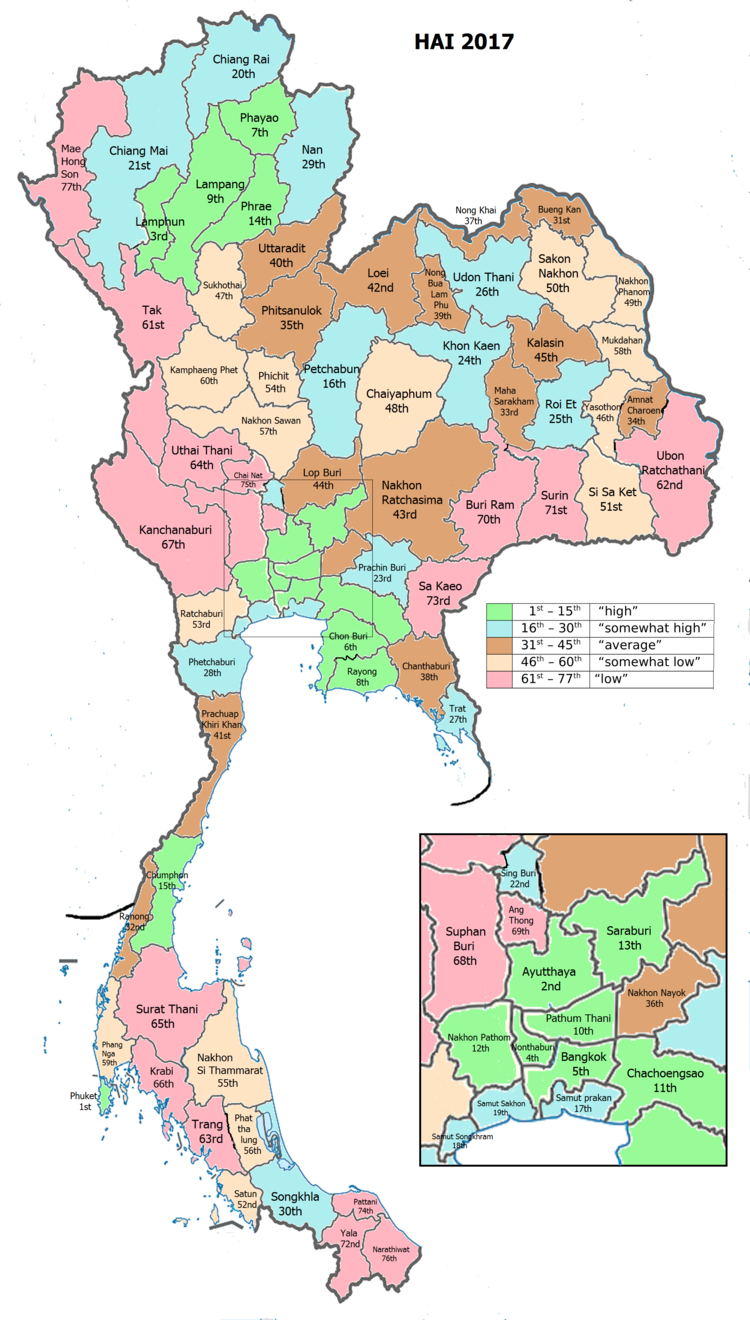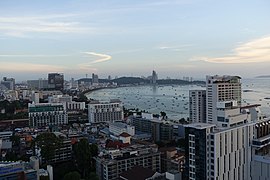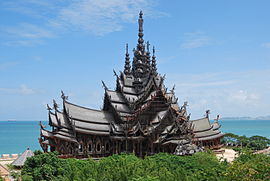Chonburi province
Chonburi
ชลบุรี | |
|---|---|
| Motto(s): ทะเลงาม ข้าวหลามอร่อย อ้อยหวาน จักสานดี ประเพณีวิ่งควาย ('Beautiful sea, Khao Lam delicious, Sweet cane, Fine weaving and Buffalo running tradition') | |
 Location within Thailand | |
| Coordinates: 13°13′N 101°11′E / 13.217°N 101.183°E | |
| Country | Thailand |
| Region | Eastern Thailand |
| Provincial Capital | Chonburi |
| Largest City | Si Racha |
| Settled | c. 7th century, as Phrarot city |
| Founded as city | 1897–1932 |
| Founded as province | 1933 |
| Governing body | Chonburi Provincial Office |
| Government | |
| • Type | Province |
| • Governor | Phakkhrathon Thianchai (since October 2016) |
| Area | |
• Province | 4,363 km2 (1,685 sq mi) |
| • Rank | 50th |
| Elevation | 50 m (160 ft) |
| Population (2018)[2] | |
• Province | 1,535,445 |
| • Rank | 9th |
| • Density | 351.9/km2 (911/sq mi) |
| • Rank | 10th |
| Human Achievement Index | |
| • HAI (2017) | 0.6613 "high" Ranked 6th |
| Time zone | UTC+07:00 (ICT) |
| Postal code | 20xxx |
| Calling code | 038 |
| ISO 3166 code | TH-20 |
Chonburi (Template:Lang-th, RTGS: Chon Buri, [tɕ͡ʰōn bū.rīː] ) is a province of Thailand (changwat) located in eastern Thailand.[4] Its capital is also named Chonburi. Neighbouring provinces are (clockwise from north) Chachoengsao, Chanthaburi, and Rayong, while the Bay of Bangkok is to the west. Pattaya, a major tourism destination in Thailand, is located in Chonburi, along with Laem Chabang, the country's primary seaport. The population of the province has grown rapidly and now totals 1.7 million residents, although a large portion of the population is floating or unregistered.[5] The registered population as of 31 December 2018 was 1.535 million.[2]
Toponymy
The Thai word chon (ชล /t͡ɕʰon˧/) originates from the Sanskrit word jalá (जल) meaning "water", and the word buri (บุรี; /bu˨˩.riː˧/) from Sanskrit purī (पुरी); meaning "town" or "city"; hence the name of the province means "city of water". The local Chinese name for the province is 萬佛歲; Bān-pu̍t-sòe, which is a rendering of "Bang Pla Soi" (บางปลาสร้อย) the former name of Mueang Chonburi district, the capital district of Chonburi province (this name is retained for one of Mueang Chonburi's subdistricts.) The standard Chinese name for the province is a phonetic rendering of "Chonburi", 春武里; Chhun-bú-lí.
History
Human habitation of the province dates back to the Neolithic era, where early inhabitants lived in the area along the Panthong river in modern day Phan Thong and Phan Thong districts.[6]
During the Dvaravati period, the city of Mueang Phra Rot (Phra That Noen That) was established close to the mouth of the Bang Pakong river in modern-day Phanat Nikhom District. The city was in the shape of an irregular rectangle and was surrounded by a moat. Mueang Phra Rot was inhbaited from the 600s to the 1000s, and had goods imported from the Tang and Song dynasties, and from either Persia or lower Mesopotamia.[7]
To the east of Phra Rot was Mueang Sri Phalo in modern-day Nong Mai Daeng, which was established near the end of Phra Rot in the 1000s.[8] Located near the mouth of the Bang Pakong river, it became a wealthy port and fishing town, serving as a stopping point for Khmer, Vietnamese and Chinese barques before they ventured into the Chao Phraya river.[6] However, it lost prominance in the 1300s when the mouth of the river became shallower due to sedimentation. As a result in the town's economy declining, its inhabitants moved south to Bang Pla Soi. Construction of Sukhimvit road erased the town's eastern wall.[8]
Late 19th century to present
In the reign of King Nangklao, Rama III, Phra Intha-asa, The Governor of Phanat Nikhom I (Princely member of Nakhon Phanom royal family) took many immigrants (Nakhon Phanom Laotians, Named Lao Asa Pak Nam) from Samut Prakan and New Nakhon Phanom Laotians to Phanat Nikhom. The Siamese King at the time allowed them to establish a habitat between Chonburi and Chachoengsao (Named Phanat Nikhom in the present).
In 1892, Ko Sichang, an island off the mainland, served as a holiday point for King Chulalongkorn and his wife Queen Saovabha Phongsri. Chulalongkorn later built a summer palace called "Phra Chuthathut Palace" named after his son, Prince Chudadhuj Dharadilok, who was born on Ko Sichang.[9] During the Franco-Siamese war of 1893, the island was occupied by the French.[10]
Following the end of World War II, coastal towns particularly Ang Sila witnessed an influx of Teochew Chinese migrants.[11] The Vietnam War would then cause an influx of American G.I.s to arrive, particularly in Pattaya. This would go on to lead Chonburi province to become popular among foreign tourists.[12]
In September 2023, the province experienced a surge in dengue fever, recording 2,987 cases and 3 deaths on 4 September. Along with dengue fever, the province is also experiencing a surge in Mpox cases, recording 26 cases in Bang Lamung district.[13]
Symbols
The provincial seal shows the hill Khao Sam Muk, on which there is a sala with a statue of the goddess Chao Mae Sahm Muk, who, it is believed, protects seafarers and the local population.[14]
The provincial tree and flower is the New Guinea rosewood (Pterocarpus indicus, called Mai Pradu in Thai).[citation needed]
The provincial motto is "Beautiful beaches, delicious khao lam, sweet sugar cane, delicate basketry products, and buffalo racing."[15]
Geography
The province is on the Bay of Bangkok, the northern end of the Gulf of Thailand. The Khao Khiao mountain range stretches from the northwest to the southeast of the province. The plains of the north were long used for farming. Laem Chabang, between Chonburi and Pattaya, is one of the few deep-water harbours of Thailand. The total forest area is 551 km2 (213 sq mi) or 12.2 percent of provincial area.[16]
Wildlife sanctuary
There is one wildlife sanctuary, along with three other wildlife sanctuaries, make up region 2 (Si Racha) of Thailand's protected areas.
- Khao Khio–Khao Chomphu Wildlife Sanctuary, 145 km2 (56 sq mi)[17]: 4
The provincial permanent legal population rose at nearly four per cent annually, from 1,040,865 in 2000 to 1,554,365 in 2010.[5] There is a large floating population of long-term non-Thai residents without permanent status, on a perpetual tourist visa and/or migrant workers (legal or not), as well as heavy, short-term tourist influxes.
Demographics
This section is empty. You can help by adding to it. (August 2019) |
Religion
According to a 2015 survey,[18] around 97.87% of the population of Chonburi practices Buddhism, followed by Islam with 1.56% and Christianity with 0.60%.
| Religion | Census 2015[18] | % |
|---|---|---|
| Buddhism | 1,256,081 | 97.87% |
| Islam | 20,000 | 1.56% |
| Christianity | 7,707 | 0.60% |
| Other religions | 800 | 0.06% |
Religion in Chonburi (census 2015)[18]
Administrative divisions
Provincial government
Chonburi province consists of 11 districts (amphoe). These are further subdivided into 92 subdistricts (tambon) and 710 villages (muban).
- Pattaya is a special governed city in Bang Lamung district.
- Laem Chabang is a port city municipality in Si Racha and Bang Lamung districts.
| Map | # | Name | Thai | Population (2018) | Subdivisions |
|---|---|---|---|---|---|

| |||||
| — Districts — | |||||
| 1 | Mueang Chonburi | เมืองชลบุรี | 335,063 | 18 tambon — 107 muban | |
| 2 | Ban Bueng | บ้านบึง | 103,377 | 8 tambon — 52 muban | |
| 3 | Nong Yai | หนองใหญ่ | 23,625 | 5 tambon — 24 muban | |
| 4 | Bang Lamung | บางละมุง | 315,437 | 8 tambon — 72 muban | |
| 5 | Phan Thong | พานทอง | 69,429 | 11 tambon — 76 muban | |
| 6 | Phanat Nikhom | พนัสนิคม | 124,637 | 20 tambon — 185 muban | |
| 7 | Si Racha | ศรีราชา | 301,799 | 8 tambon — 73 muban | |
| 8 | Ko Sichang | เกาะสีชัง | 4,560 | 1 tambon — 7 muban | |
| 9 | Sattahip | สัตหีบ | 165,492 | 5 tambon — 40 muban | |
| 10 | Bo Thong | บ่อทอง | 50,318 | 6 tambon — 47 muban | |
| 11 | Ko Chan | เกาะจันทร์ | 37,670 | 2 tambon — 27 muban | |
Local government
The local governments are overseen by the Pattaya City Special Local Government in Pattaya and the Chonburi Provincial Administrative Organisation (CPOA, ongkan borihan suan changwat chonburi) throughout Chonburi. The 47 municipalities are split up into two city municipalities (thesaban nakhon), 10 town municipalities (thesaban mueang),[19] and 35 subdistrict municipalities (thesaban tambon). Local communities are also overseen by 50 subdistrict administrative organisations (SAO, ongkan borihan suan tambon).[20]
Transport
Road
The Bangkok-Chonburi-Pattaya Motorway (Hwy 7) is linked with Bangkok's Outer Ring Road (Hwy 9) with another intersection at Si Nakharin and Rama IX Junction.
The Bang Na-Trat Highway (Hwy 34) from Bang Na travels through Bang Phli and crosses the Bang Pakong River into Chonburi. There is a Chonburi bypass that meets Sukhumvit Road (Hwy 3), passing Bang Saen Beach, Bang Phra, Pattaya and Sattahip.
Airports
Chonburi is about 120 kilometres (75 mi) by road from Suvarnabhumi Airport (BKK), the country's largest international airport. By road, it is accessed from Sukhumvit Road and Motorway 7 from Bangkok. Chonburi is also served by scheduled flights via U-Tapao International Airport (UTP), which is a 45-minute drive south of the city.
Highways
The main road through Chonburi is Thailand Route 3, also known as Sukhumvit Road. To the northeast, it connects to Bangkok, and to the south, it connects to Rayong province, Chanthaburi province and Trat province. Route 344 leads east to Klaeng (which is also on Route 3). Route 7 runs parallel to Route 3 but bypasses the densely populated coastal area, connecting to the beach resort city of Pattaya.
Rail
The State Railway of Thailand, the national passenger rail system, provides service in the province, with the main station being Chon Buri Railway Station.
Health
Many hospitals exist in Chonburi, both public and private. Chonburi has one university hospital, Burapha University Hospital. Its main hospital operated by the Ministry of Public Health is Chonburi Hospital. Hospitals operated by other organisations, such as the Thai Red Cross Society's Queen Savang Vadhana Memorial Hospital and the Queen Sirikit Naval Hospital run by the Royal Thai Navy, are also found in the province.
Educational facilities
Universities
- Burapha University (BUU)
- Kasetsart University Si Racha Campus (KU SRC)
- Rajamangala University of Technology Tawan-ok (RMUTTO)
- Sripatum University Chonburi Campus (SPU)
- Thailand National Sports University (TNSU)
- Thammasat University Pattaya Campus (TU)
Colleges
- Graduate School of Public Administration, National Institute of Development Administration (GSPA NIDA)
- Interior College (IC)
- Panyapiwat Institute of Management (PIM)
Human Achievement Index 2017
| Health | Education | Employment | Income |
| 34 | 2 | 2 | 7 |
| Housing | Family | Transport | Participation |

|
 |

|
|
| 74 | 18 | 5 | 72 |
| Province Chonburi, with an HAI 2017 value of 0.6613 is "high", occupies place 6 in the ranking. | |||
Since 2003, the United Nations Development Programme (UNDP) in Thailand has tracked progress on human development at a sub-national level using the Human Achievement Index (HAI), a composite index covering all eight key areas of human development. The National Economic and Social Development Board (NESDB) has taken over this task since 2017.[3]
| Rank | Classification |
| 1 - 15 | "high" |
| 16 - 30 | "somewhat high" |
| 31 - 45 | "average" |
| 45 - 60 | "somewhat low" |
| 61 - 77 | "low" |
| Map with provinces and HAI 2017 rankings |

|
Tourism
Some nine million visitors to the province were recorded in 2012, of which 6.1 million were from abroad, 2.2 million of these being Russian.[21]
One major tourist attraction is the Chonburi Buffalo Race (งานประเพณีวิ่งควาย), which takes place in the districts of Ban Bueng and Nong Yai. The animals are dressed outrageously or creatively by owners. Assembled in the courtyard in front of the town hall, the buffaloes partake in racing or physical fitness and fashion contests. The Chonburi Buffalo Race festival started over 100 years ago.[22] Usually, the races will be complemented with booths selling locally-made items, stage performances, games, and beauty contests.[23] The annual Buffalo Race is held around the 11th lunar month, normally in October. It takes seven days and takes place on the field in front of the city and provincial government offices. The highlight of the festival is the buffalo race, which takes place on the last two days. This race is 100 metres (110 yd) long. The prize for the first nose past the finish line is a trophy and some money.[24]
Songkran day in Bangsaen (Ko Phra Sai Wan Lai Bangsaen) is a tradition that has been held continuously for over ten years at Bang Saen Beach and Laem Thaen. The event takes place between April 16–17 of each year. The highlight of this event is a contest in which the contestants build a sand Buddha at Bangsaen Beach. In each Buddha sand arch is a decoration. The combination of the sea atmosphere and Thai decorations has helped this become one of the most popular Songkran festivals in Thailand. Other activities also take place, such as meriting alms to monks, bathing Buddha images, pouring water on the elders, traditional sporting events, sea boxing competitions, and oyster sheep competitions. Seafood and local food are often sold, along with other local products as part of One Tambon One Product (OTOP). Well-known artists have also given concerts at the event.
See also
References
- ^ Advancing Human Development through the ASEAN Community, Thailand Human Development Report 2014, table 0:Basic Data (PDF) (Report). United Nations Development Programme (UNDP) Thailand. pp. 134–135. ISBN 978-974-680-368-7. Retrieved 17 January 2016, Data has been supplied by Land Development Department, Ministry of Agriculture and Cooperatives, at Wayback Machine.
{{cite report}}: CS1 maint: postscript (link)[dead link] - ^ a b "ร่ยงานสถิติจำนวนประชากรและบ้านประจำปี พ.ศ.2561" [Statistics, population and house statistics for the year 2018]. Registration Office Department of the Interior, Ministry of the Interior. stat.bora.dopa.go.th (in Thai). 31 December 2018. Archived from the original on 2 April 2019. Retrieved 20 June 2019.
- ^ a b Human achievement index 2017 by National Economic and Social Development Board (NESDB), pp. 1–40, maps 1–9, retrieved 14 September 2019, ISBN 978-974-9769-33-1.
- ^ "About Chon Buri". Tourism Authority of Thailand (TAT). Retrieved 31 May 2015.
- ^ a b "Thailand: Administrative Division (Provinces and Districts) - Population Statistics, Charts and Map".
- ^ a b "History". สำนักงานการท่องเที่ยวและกีฬาจังหวัดชลบุรี. Retrieved 2023-09-10.
- ^ "Mueang Phra Rot - Archeological site". RouteYou. Retrieved 2023-09-10.
- ^ a b "Mueang Sri Phalo - Archeological site". RouteYou. Retrieved 2023-09-10.
- ^ "Ko Sichang". Thailandtourismdirectory.com. Retrieved 26 August 2018.
- ^ "พิพิธภัณฑ์พระจุฑาธุชราชฐานเกาะสีชัง – CU100". Cu100.chula.ac.th. Retrieved 26 August 2018.
- ^ "Ang Sila". www.tourismthailand.org. Retrieved 2023-09-11.
- ^ "Pattaya history, Introduction to Pattaya, festivals and events". 2020-02-25. Archived from the original on 2020-02-25. Retrieved 2023-09-11.
- ^ Fronde, Neill (2023-09-06). "Bang Lamung takes break from chlamydia, gonorrhea to deal with dengue fever, Covid, monkeypox". Thaiger. Retrieved 2023-09-10.
- ^ "Chonburi". THAILEX Travel Encyclopedia. Archived from the original on 2015-11-27. Retrieved 31 May 2015.
- ^ "History". สำนักงานการท่องเที่ยวและกีฬาจังหวัดชลบุรี. Retrieved 2019-05-23.
- ^ "ตารางที่ 2 พี้นที่ป่าไม้ แยกรายจังหวัด พ.ศ.2562" [Table 2 Forest area Separate province year 2019]. Royal Forest Department (in Thai). 2019. Retrieved 6 April 2021, information, Forest statistics Year 2019
{{cite web}}: CS1 maint: postscript (link) - ^ "ตาราง 5 พื้นที่เขตรักษาพันธุ์สัตว์ป่า พ.ศ. 2562" [Table 5 Wildlife Sanctuary Areas in 2019] (PDF). Department of National Parks, Wildlife Sanctuaries and Plant Conservation (in Thai). 2019. Retrieved 1 November 2022.
- ^ a b c http://cbi.onab.go.th/index.php?option=com_content&view=article&id=327&Itemid=206 Religion in Chonburi
- ^ "ข้อมูลพื้นฐานของอปท" [Basic information of local authorities] (in Thai). 2020. Retrieved 22 September 2020.
- ^ https://www.dla.go.th/work/abt/index.jsp Archived 2019-07-19 at the Wayback Machine Thesaban - 14 June 2562 (2019)
- ^ "Chon Buri sees 9mn visitors in 2012". The Nation. 8 April 2013. Retrieved 2 October 2018.
- ^ สำนักงานคณะกรรมการวัฒนธรรมแห่งชาติ, ประเพณีวิ่งควาย (1994). ชีวิตไทยชุดบรรพบุรุษของเรา.กรุงเทพฯ: คุรุสภาลาดพร้าว, 2013
- ^ "Chonburi buffalos race Oct. 14-20". Pattaya Mail. 2013-09-06. Archived from the original on 10 June 2015. Retrieved 31 May 2015.
- ^ "Chonburi Buffalo Racing". Tourism Authority of Thailand (TAT). Archived from the original on 19 April 2019. Retrieved 19 April 2019.
External links
 Chonburi travel guide from Wikivoyage
Chonburi travel guide from Wikivoyage- Provincial administration (Thai)










